Purdue Global: Sickle Cell Anemia Case Study Analysis and Insights
VerifiedAdded on 2022/10/16
|6
|1289
|271
Case Study
AI Summary
This case study examines a scenario involving Marsha and Clement, both carriers of sickle cell disease (SCD), and their concerns about future pregnancies. The assignment delves into the autosomal recessive nature of SCD, emphasizing that both parents must carry the abnormal gene for the child to be affected. It explores the probabilities of offspring inheriting the disease or becoming carriers, considering the couple's existing child and the implications for future children. The analysis clarifies misconceptions about gender-specific risks and assesses the potential outcomes for their daughter, Amelia, based on her future partner's genetic status. The case study concludes with recommendations to address Marsha's concerns, providing insights into the disease's inheritance patterns and offering guidance for healthcare practitioners.
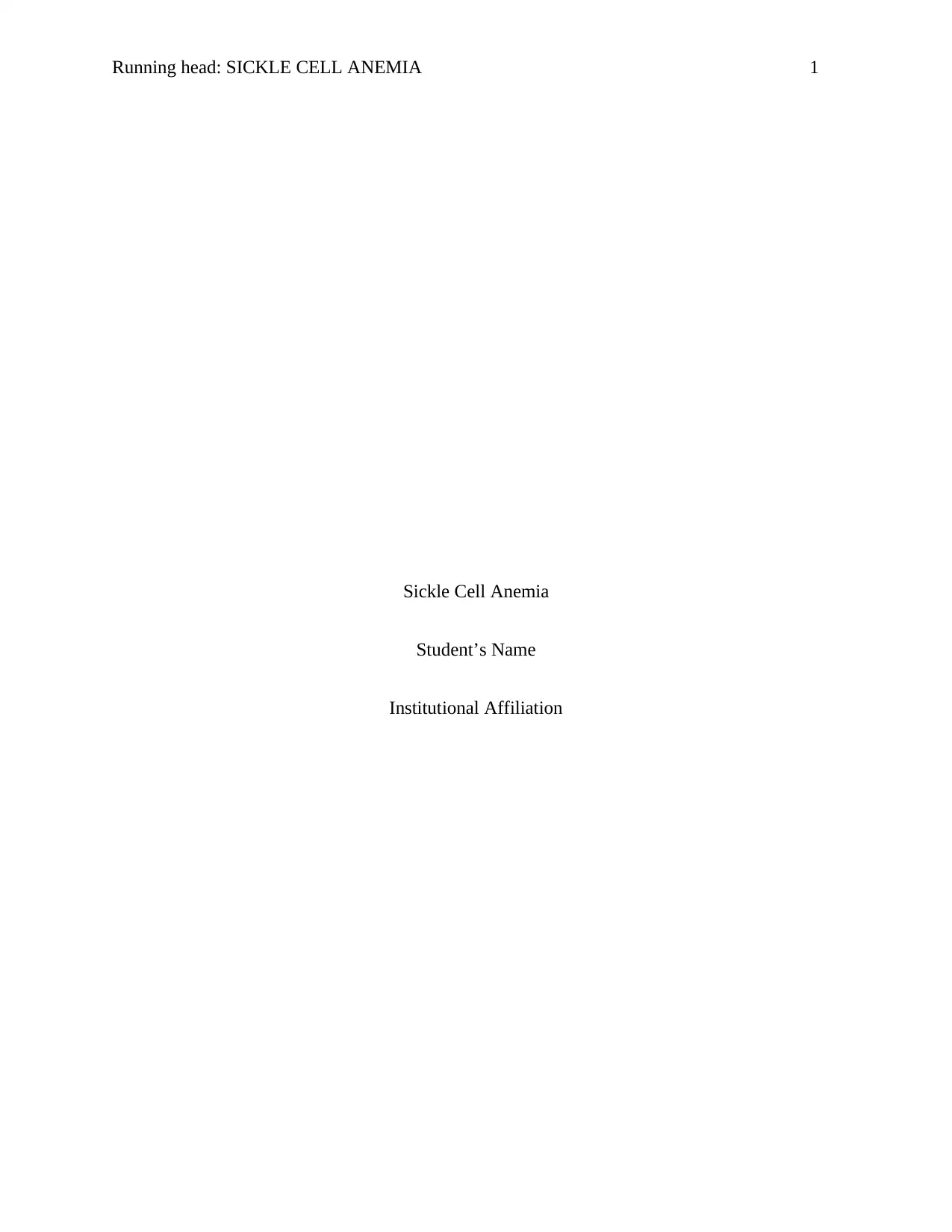
Running head: SICKLE CELL ANEMIA 1
Sickle Cell Anemia
Student’s Name
Institutional Affiliation
Sickle Cell Anemia
Student’s Name
Institutional Affiliation
Paraphrase This Document
Need a fresh take? Get an instant paraphrase of this document with our AI Paraphraser
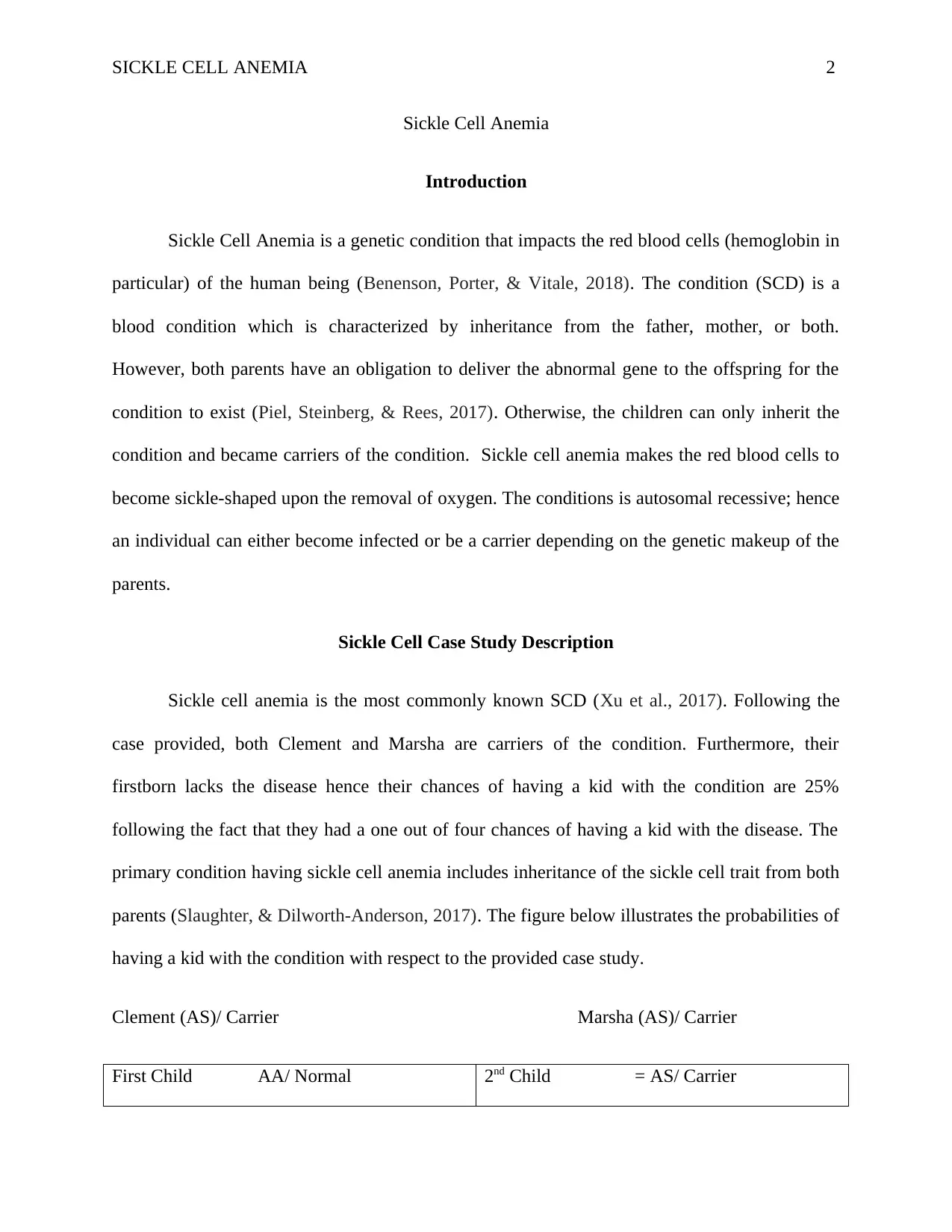
SICKLE CELL ANEMIA 2
Sickle Cell Anemia
Introduction
Sickle Cell Anemia is a genetic condition that impacts the red blood cells (hemoglobin in
particular) of the human being (Benenson, Porter, & Vitale, 2018). The condition (SCD) is a
blood condition which is characterized by inheritance from the father, mother, or both.
However, both parents have an obligation to deliver the abnormal gene to the offspring for the
condition to exist (Piel, Steinberg, & Rees, 2017). Otherwise, the children can only inherit the
condition and became carriers of the condition. Sickle cell anemia makes the red blood cells to
become sickle-shaped upon the removal of oxygen. The conditions is autosomal recessive; hence
an individual can either become infected or be a carrier depending on the genetic makeup of the
parents.
Sickle Cell Case Study Description
Sickle cell anemia is the most commonly known SCD (Xu et al., 2017). Following the
case provided, both Clement and Marsha are carriers of the condition. Furthermore, their
firstborn lacks the disease hence their chances of having a kid with the condition are 25%
following the fact that they had a one out of four chances of having a kid with the disease. The
primary condition having sickle cell anemia includes inheritance of the sickle cell trait from both
parents (Slaughter, & Dilworth-Anderson, 2017). The figure below illustrates the probabilities of
having a kid with the condition with respect to the provided case study.
Clement (AS)/ Carrier Marsha (AS)/ Carrier
First Child AA/ Normal 2nd Child = AS/ Carrier
Sickle Cell Anemia
Introduction
Sickle Cell Anemia is a genetic condition that impacts the red blood cells (hemoglobin in
particular) of the human being (Benenson, Porter, & Vitale, 2018). The condition (SCD) is a
blood condition which is characterized by inheritance from the father, mother, or both.
However, both parents have an obligation to deliver the abnormal gene to the offspring for the
condition to exist (Piel, Steinberg, & Rees, 2017). Otherwise, the children can only inherit the
condition and became carriers of the condition. Sickle cell anemia makes the red blood cells to
become sickle-shaped upon the removal of oxygen. The conditions is autosomal recessive; hence
an individual can either become infected or be a carrier depending on the genetic makeup of the
parents.
Sickle Cell Case Study Description
Sickle cell anemia is the most commonly known SCD (Xu et al., 2017). Following the
case provided, both Clement and Marsha are carriers of the condition. Furthermore, their
firstborn lacks the disease hence their chances of having a kid with the condition are 25%
following the fact that they had a one out of four chances of having a kid with the disease. The
primary condition having sickle cell anemia includes inheritance of the sickle cell trait from both
parents (Slaughter, & Dilworth-Anderson, 2017). The figure below illustrates the probabilities of
having a kid with the condition with respect to the provided case study.
Clement (AS)/ Carrier Marsha (AS)/ Carrier
First Child AA/ Normal 2nd Child = AS/ Carrier
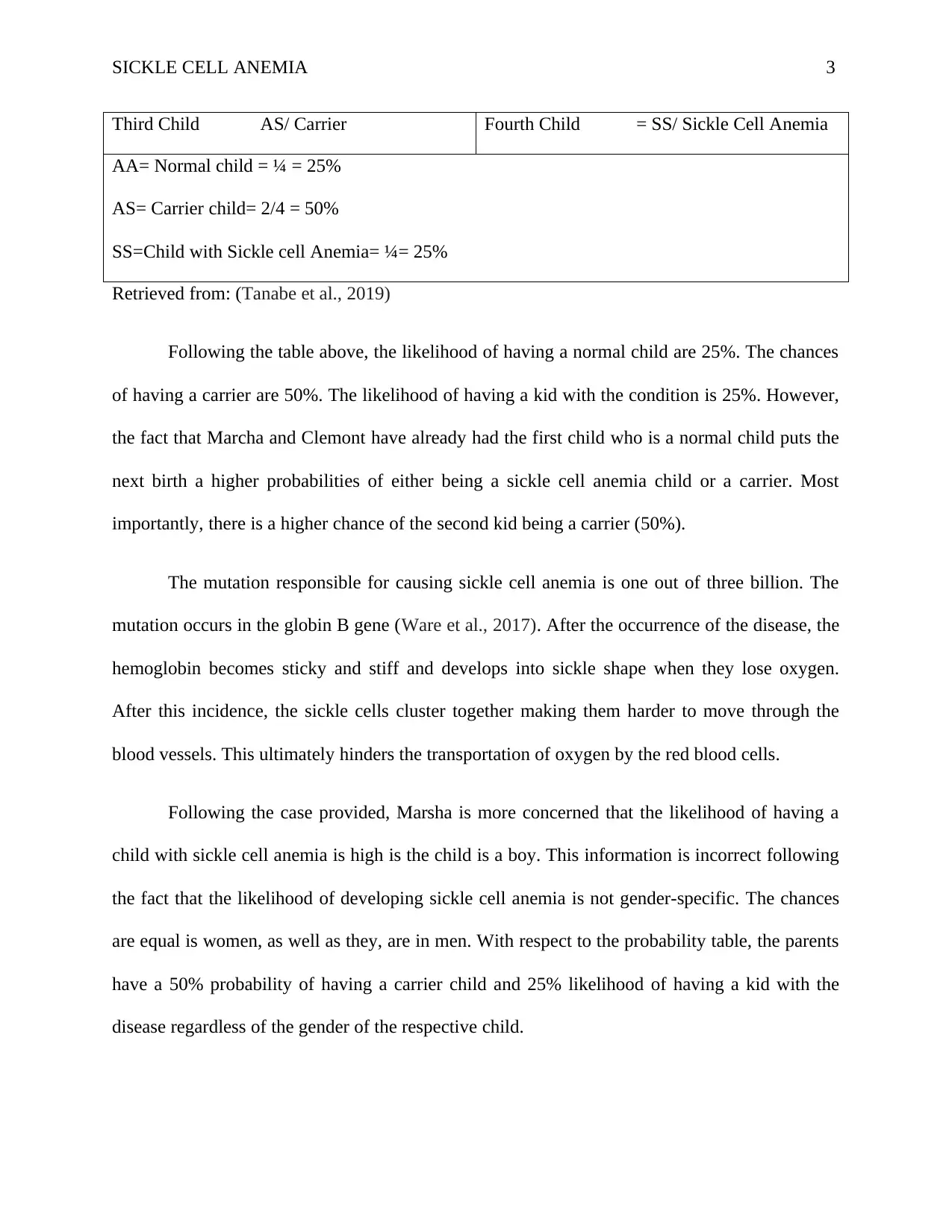
SICKLE CELL ANEMIA 3
Third Child AS/ Carrier Fourth Child = SS/ Sickle Cell Anemia
AA= Normal child = ¼ = 25%
AS= Carrier child= 2/4 = 50%
SS=Child with Sickle cell Anemia= ¼= 25%
Retrieved from: (Tanabe et al., 2019)
Following the table above, the likelihood of having a normal child are 25%. The chances
of having a carrier are 50%. The likelihood of having a kid with the condition is 25%. However,
the fact that Marcha and Clemont have already had the first child who is a normal child puts the
next birth a higher probabilities of either being a sickle cell anemia child or a carrier. Most
importantly, there is a higher chance of the second kid being a carrier (50%).
The mutation responsible for causing sickle cell anemia is one out of three billion. The
mutation occurs in the globin B gene (Ware et al., 2017). After the occurrence of the disease, the
hemoglobin becomes sticky and stiff and develops into sickle shape when they lose oxygen.
After this incidence, the sickle cells cluster together making them harder to move through the
blood vessels. This ultimately hinders the transportation of oxygen by the red blood cells.
Following the case provided, Marsha is more concerned that the likelihood of having a
child with sickle cell anemia is high is the child is a boy. This information is incorrect following
the fact that the likelihood of developing sickle cell anemia is not gender-specific. The chances
are equal is women, as well as they, are in men. With respect to the probability table, the parents
have a 50% probability of having a carrier child and 25% likelihood of having a kid with the
disease regardless of the gender of the respective child.
Third Child AS/ Carrier Fourth Child = SS/ Sickle Cell Anemia
AA= Normal child = ¼ = 25%
AS= Carrier child= 2/4 = 50%
SS=Child with Sickle cell Anemia= ¼= 25%
Retrieved from: (Tanabe et al., 2019)
Following the table above, the likelihood of having a normal child are 25%. The chances
of having a carrier are 50%. The likelihood of having a kid with the condition is 25%. However,
the fact that Marcha and Clemont have already had the first child who is a normal child puts the
next birth a higher probabilities of either being a sickle cell anemia child or a carrier. Most
importantly, there is a higher chance of the second kid being a carrier (50%).
The mutation responsible for causing sickle cell anemia is one out of three billion. The
mutation occurs in the globin B gene (Ware et al., 2017). After the occurrence of the disease, the
hemoglobin becomes sticky and stiff and develops into sickle shape when they lose oxygen.
After this incidence, the sickle cells cluster together making them harder to move through the
blood vessels. This ultimately hinders the transportation of oxygen by the red blood cells.
Following the case provided, Marsha is more concerned that the likelihood of having a
child with sickle cell anemia is high is the child is a boy. This information is incorrect following
the fact that the likelihood of developing sickle cell anemia is not gender-specific. The chances
are equal is women, as well as they, are in men. With respect to the probability table, the parents
have a 50% probability of having a carrier child and 25% likelihood of having a kid with the
disease regardless of the gender of the respective child.
⊘ This is a preview!⊘
Do you want full access?
Subscribe today to unlock all pages.

Trusted by 1+ million students worldwide
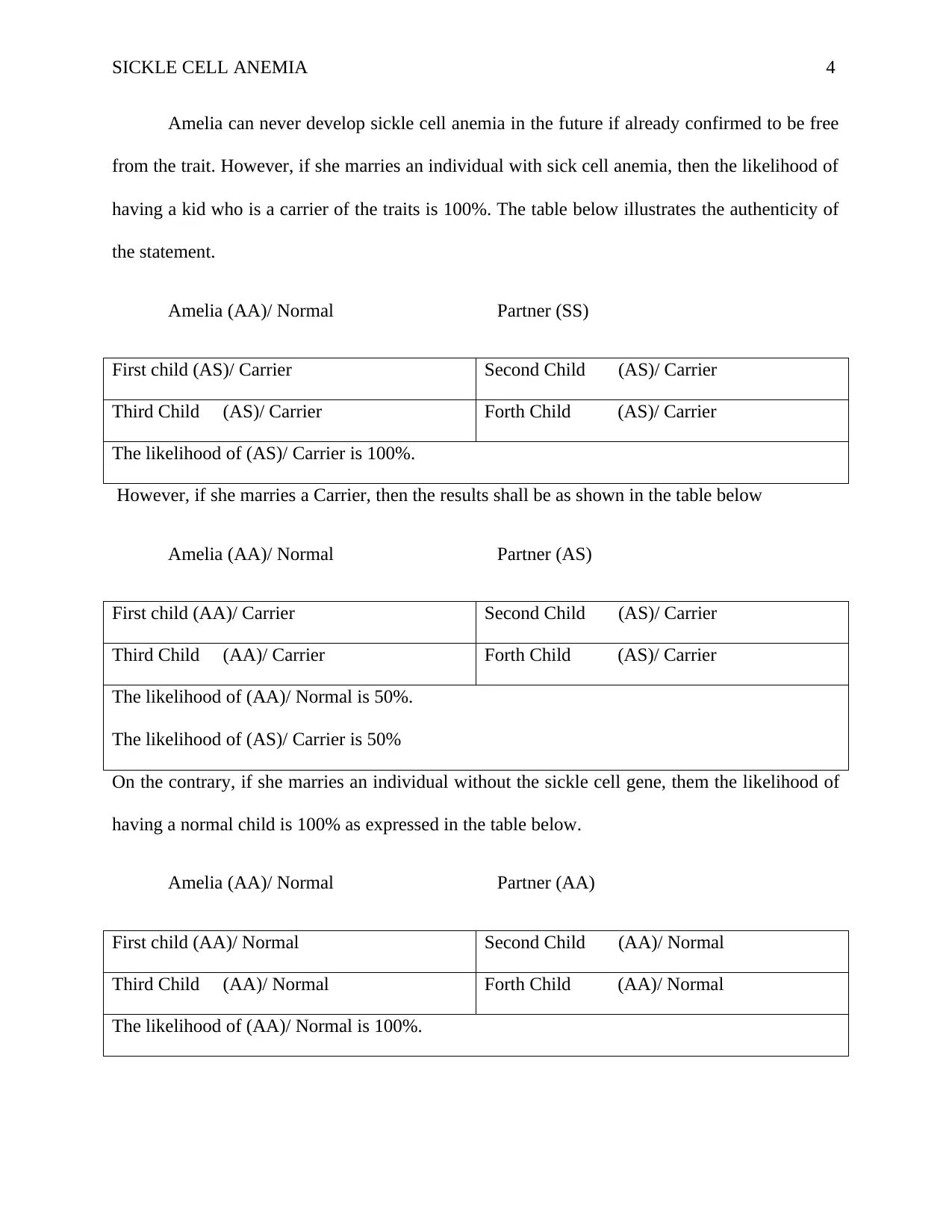
SICKLE CELL ANEMIA 4
Amelia can never develop sickle cell anemia in the future if already confirmed to be free
from the trait. However, if she marries an individual with sick cell anemia, then the likelihood of
having a kid who is a carrier of the traits is 100%. The table below illustrates the authenticity of
the statement.
Amelia (AA)/ Normal Partner (SS)
First child (AS)/ Carrier Second Child (AS)/ Carrier
Third Child (AS)/ Carrier Forth Child (AS)/ Carrier
The likelihood of (AS)/ Carrier is 100%.
However, if she marries a Carrier, then the results shall be as shown in the table below
Amelia (AA)/ Normal Partner (AS)
First child (AA)/ Carrier Second Child (AS)/ Carrier
Third Child (AA)/ Carrier Forth Child (AS)/ Carrier
The likelihood of (AA)/ Normal is 50%.
The likelihood of (AS)/ Carrier is 50%
On the contrary, if she marries an individual without the sickle cell gene, them the likelihood of
having a normal child is 100% as expressed in the table below.
Amelia (AA)/ Normal Partner (AA)
First child (AA)/ Normal Second Child (AA)/ Normal
Third Child (AA)/ Normal Forth Child (AA)/ Normal
The likelihood of (AA)/ Normal is 100%.
Amelia can never develop sickle cell anemia in the future if already confirmed to be free
from the trait. However, if she marries an individual with sick cell anemia, then the likelihood of
having a kid who is a carrier of the traits is 100%. The table below illustrates the authenticity of
the statement.
Amelia (AA)/ Normal Partner (SS)
First child (AS)/ Carrier Second Child (AS)/ Carrier
Third Child (AS)/ Carrier Forth Child (AS)/ Carrier
The likelihood of (AS)/ Carrier is 100%.
However, if she marries a Carrier, then the results shall be as shown in the table below
Amelia (AA)/ Normal Partner (AS)
First child (AA)/ Carrier Second Child (AS)/ Carrier
Third Child (AA)/ Carrier Forth Child (AS)/ Carrier
The likelihood of (AA)/ Normal is 50%.
The likelihood of (AS)/ Carrier is 50%
On the contrary, if she marries an individual without the sickle cell gene, them the likelihood of
having a normal child is 100% as expressed in the table below.
Amelia (AA)/ Normal Partner (AA)
First child (AA)/ Normal Second Child (AA)/ Normal
Third Child (AA)/ Normal Forth Child (AA)/ Normal
The likelihood of (AA)/ Normal is 100%.
Paraphrase This Document
Need a fresh take? Get an instant paraphrase of this document with our AI Paraphraser
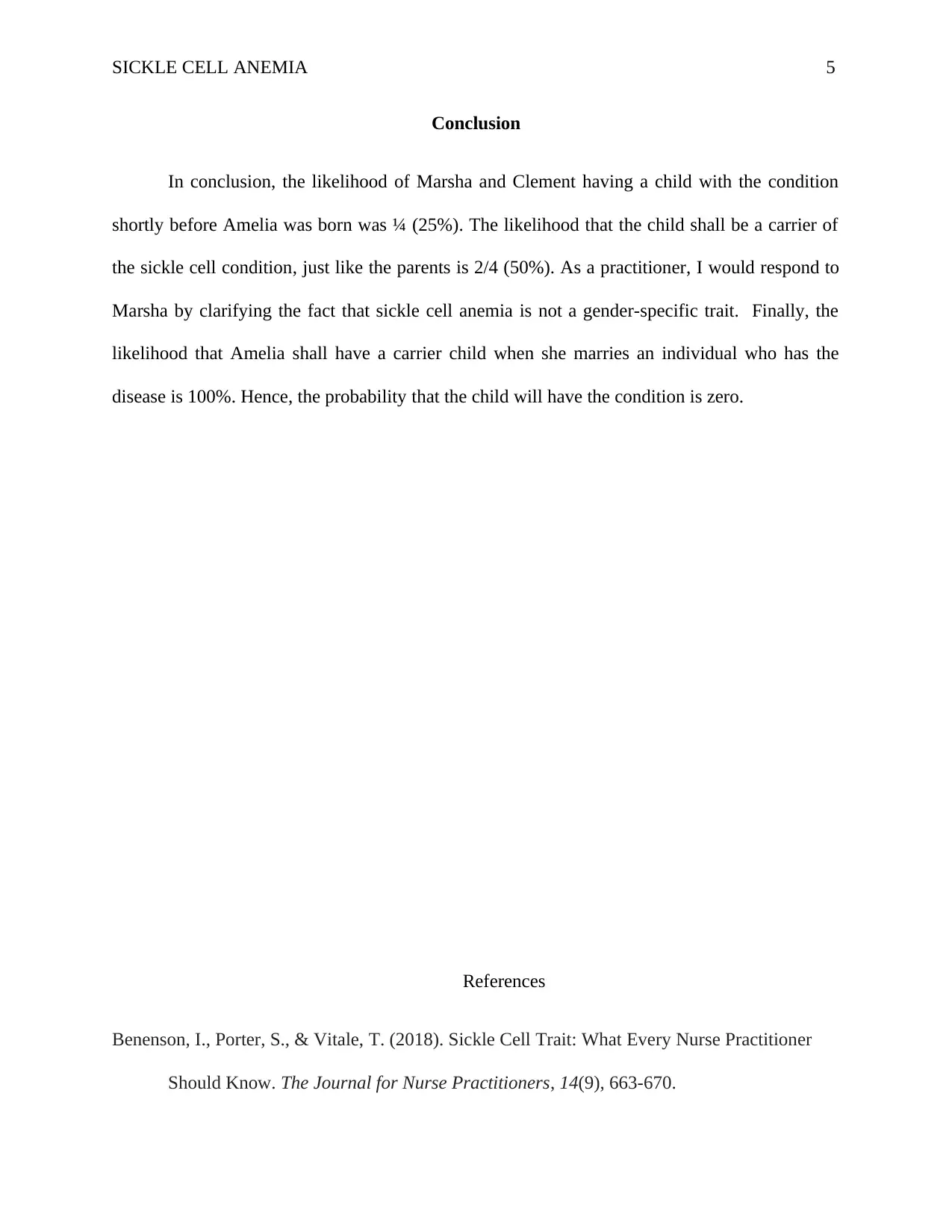
SICKLE CELL ANEMIA 5
Conclusion
In conclusion, the likelihood of Marsha and Clement having a child with the condition
shortly before Amelia was born was ¼ (25%). The likelihood that the child shall be a carrier of
the sickle cell condition, just like the parents is 2/4 (50%). As a practitioner, I would respond to
Marsha by clarifying the fact that sickle cell anemia is not a gender-specific trait. Finally, the
likelihood that Amelia shall have a carrier child when she marries an individual who has the
disease is 100%. Hence, the probability that the child will have the condition is zero.
References
Benenson, I., Porter, S., & Vitale, T. (2018). Sickle Cell Trait: What Every Nurse Practitioner
Should Know. The Journal for Nurse Practitioners, 14(9), 663-670.
Conclusion
In conclusion, the likelihood of Marsha and Clement having a child with the condition
shortly before Amelia was born was ¼ (25%). The likelihood that the child shall be a carrier of
the sickle cell condition, just like the parents is 2/4 (50%). As a practitioner, I would respond to
Marsha by clarifying the fact that sickle cell anemia is not a gender-specific trait. Finally, the
likelihood that Amelia shall have a carrier child when she marries an individual who has the
disease is 100%. Hence, the probability that the child will have the condition is zero.
References
Benenson, I., Porter, S., & Vitale, T. (2018). Sickle Cell Trait: What Every Nurse Practitioner
Should Know. The Journal for Nurse Practitioners, 14(9), 663-670.
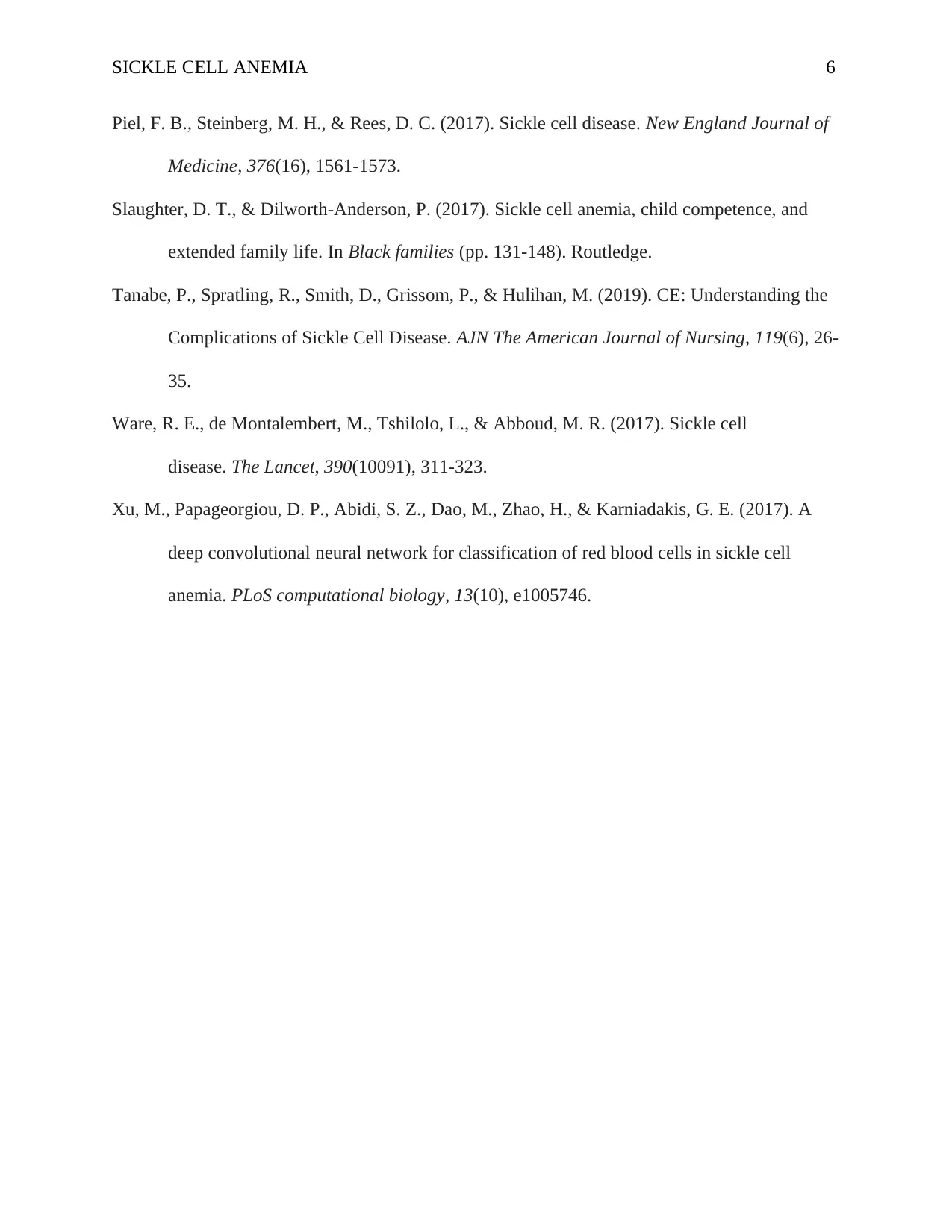
SICKLE CELL ANEMIA 6
Piel, F. B., Steinberg, M. H., & Rees, D. C. (2017). Sickle cell disease. New England Journal of
Medicine, 376(16), 1561-1573.
Slaughter, D. T., & Dilworth-Anderson, P. (2017). Sickle cell anemia, child competence, and
extended family life. In Black families (pp. 131-148). Routledge.
Tanabe, P., Spratling, R., Smith, D., Grissom, P., & Hulihan, M. (2019). CE: Understanding the
Complications of Sickle Cell Disease. AJN The American Journal of Nursing, 119(6), 26-
35.
Ware, R. E., de Montalembert, M., Tshilolo, L., & Abboud, M. R. (2017). Sickle cell
disease. The Lancet, 390(10091), 311-323.
Xu, M., Papageorgiou, D. P., Abidi, S. Z., Dao, M., Zhao, H., & Karniadakis, G. E. (2017). A
deep convolutional neural network for classification of red blood cells in sickle cell
anemia. PLoS computational biology, 13(10), e1005746.
Piel, F. B., Steinberg, M. H., & Rees, D. C. (2017). Sickle cell disease. New England Journal of
Medicine, 376(16), 1561-1573.
Slaughter, D. T., & Dilworth-Anderson, P. (2017). Sickle cell anemia, child competence, and
extended family life. In Black families (pp. 131-148). Routledge.
Tanabe, P., Spratling, R., Smith, D., Grissom, P., & Hulihan, M. (2019). CE: Understanding the
Complications of Sickle Cell Disease. AJN The American Journal of Nursing, 119(6), 26-
35.
Ware, R. E., de Montalembert, M., Tshilolo, L., & Abboud, M. R. (2017). Sickle cell
disease. The Lancet, 390(10091), 311-323.
Xu, M., Papageorgiou, D. P., Abidi, S. Z., Dao, M., Zhao, H., & Karniadakis, G. E. (2017). A
deep convolutional neural network for classification of red blood cells in sickle cell
anemia. PLoS computational biology, 13(10), e1005746.
⊘ This is a preview!⊘
Do you want full access?
Subscribe today to unlock all pages.

Trusted by 1+ million students worldwide
1 out of 6
Related Documents
Your All-in-One AI-Powered Toolkit for Academic Success.
+13062052269
info@desklib.com
Available 24*7 on WhatsApp / Email
![[object Object]](/_next/static/media/star-bottom.7253800d.svg)
Unlock your academic potential
Copyright © 2020–2025 A2Z Services. All Rights Reserved. Developed and managed by ZUCOL.





